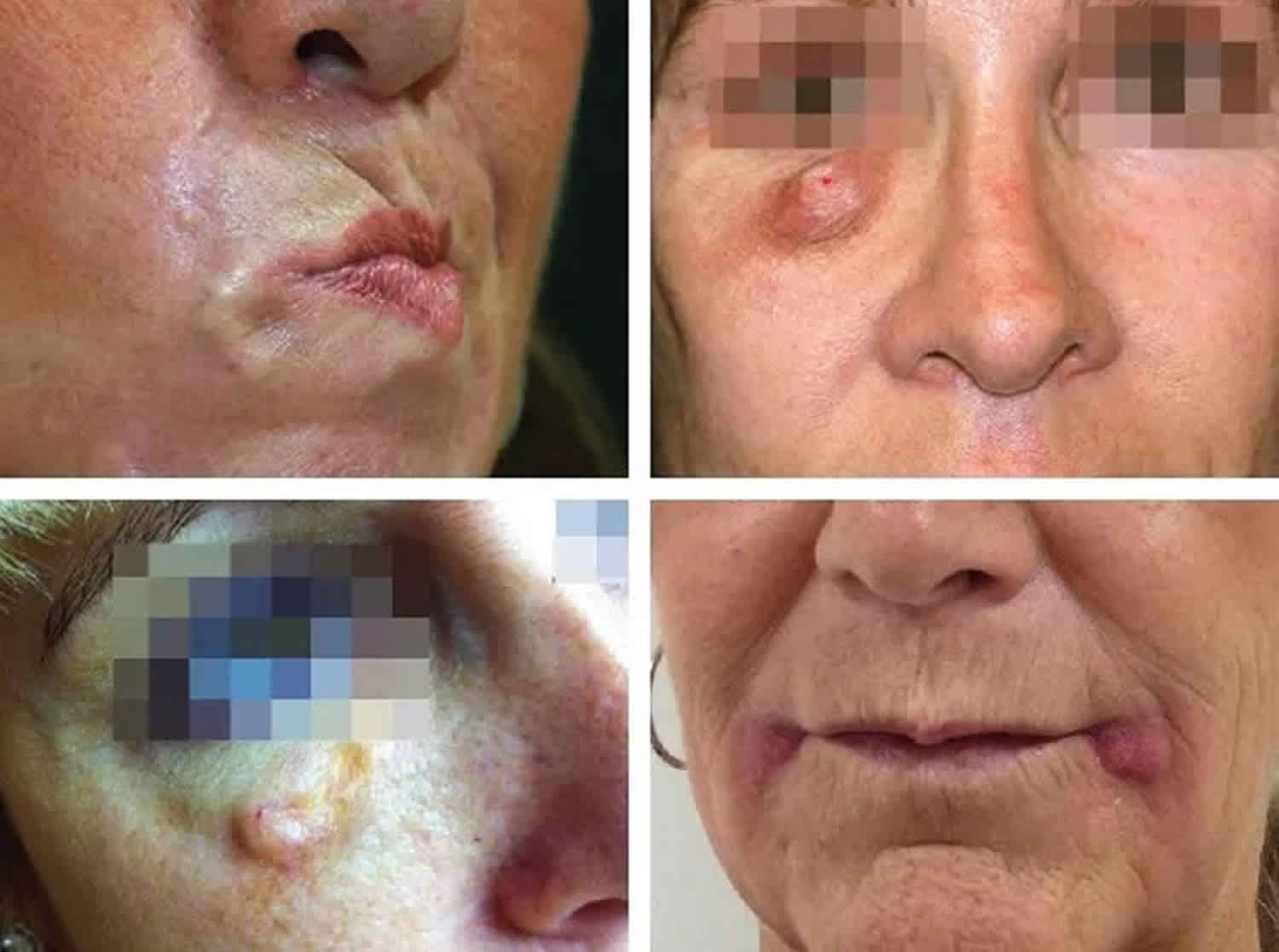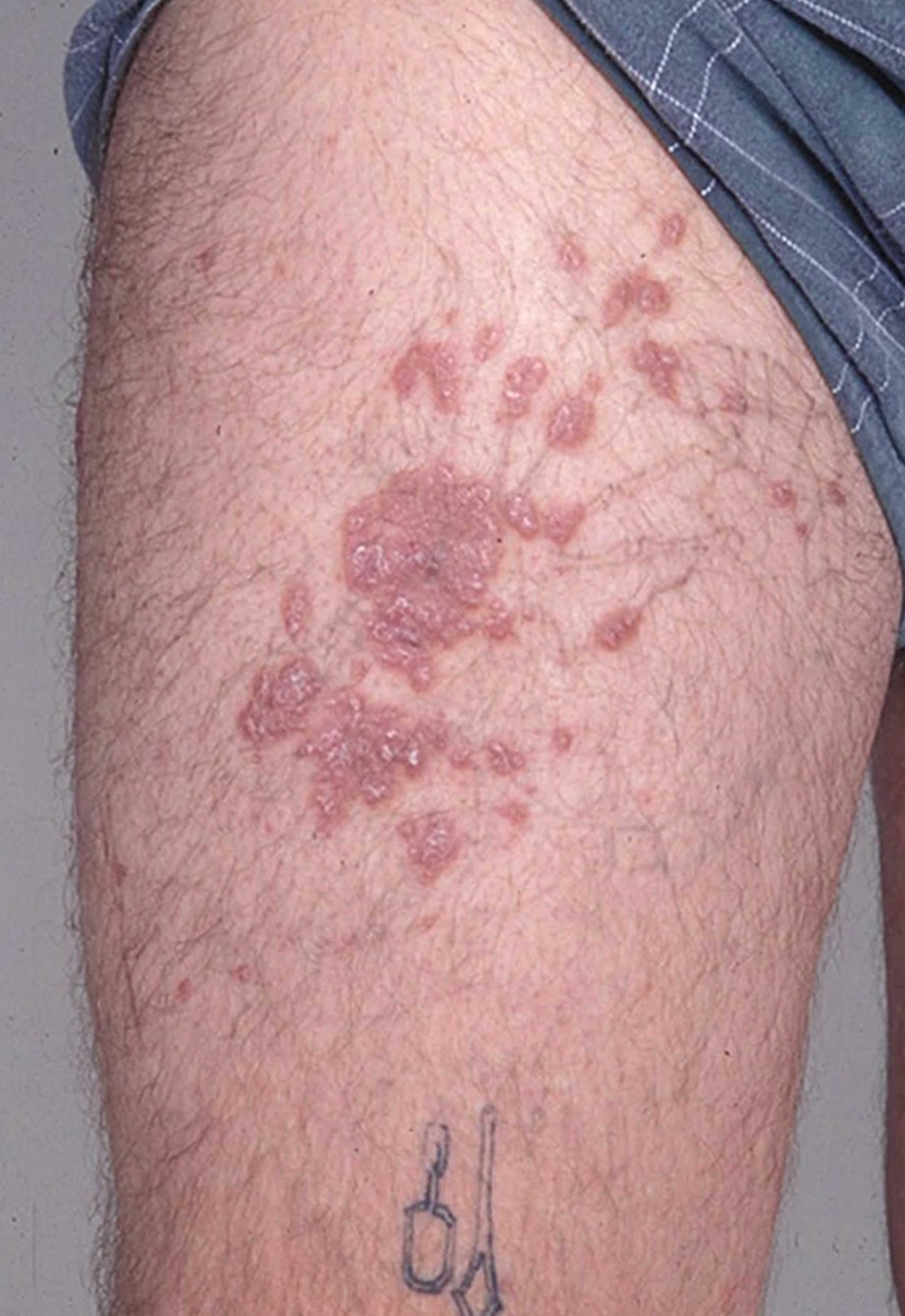Foreign body granuloma
Foreign body granuloma is a response of biological tissue to any foreign material in the tissue 1. A granuloma is focal collection of inflammatory cells at sites of tissue infection and includes activated macrophages (epithelioid cells), Langhans’ giant cells, and lymphocytes. A foreign body is any material, living or non–living, that is recognized by host immunity to be ‘non-self’ and elicits an immunological response. A granuloma is a histological term for a collection of histiocytes or epithelioid histiocytes accompanied by a range of multinucleated giant cells (masses of macrophages) and other inflammatory cells 2. A foreign body granuloma forms in response to the introduction of exogenous material to the skin, or in response to modified endogenous material that the immune system identifies as foreign 3. Foreign bodies are most commonly introduced into the body through voluntary means, such as tattoos and cosmetic fillers. Involuntary causes of foreign body granulomas, such as minerals and metals accidentally imbedded in the skin, are often seen in those who work in construction industries 3.
Your body mounts an inflammatory reaction to get rid of foreign bodies. Neutrophils form the initial host defence by attempting to envelop and digest (phagocytose) the foreign material. If this response is not sufficient in eliminating the foreign body, then monocytes and local tissue macrophages will be activated to engulf the foreign material. If the foreign body is small enough, these cells will effectively remove it from the tissue 3.
If foreign bodies are present on the surface of the skin such as debris in a wound, keratinocytes migrate along the connective tissue formed by fibrin, fibronectin and type V collagen, and dissect it from the underlying tissue during the proliferative phase of healing.
Figure 1. Foreign body granuloma of skin from tattooing
Foreign body granuloma causes
A foreign body granuloma forms when the host immune system is unable to digest the foreign body, resulting in the accumulation of macrophages and histiocytes. As macrophages surround and isolate the foreign body, some of them will fuse to form multinucleated giant cells. T cells and fibroblasts also participate in this inflammatory response 3.
Substances that cause foreign body granulomas include:
- Carbon pigments in cosmetic tattoos, and industrial and firearm accidents
- Cosmetic fillers, such as collagen, silicone, paraffin and hyaluronic acid
- Medications, such as intralesional corticosteroids, polyvinylpyrrolidone and hydroquinone
- Mineral and metallic particles, such as road gravel, silica, aluminium, zinc and nickel
- Ruptured cyst, hairs, calcium
- Other biotic and abiotic materials, such as talc, cactus spines, glass, retained sutures, splinters, and natural and artificial hair.
Foreign body granuloma differential diagnosis
The differential diagnosis of foreign body granulomas includes other forms of granuloma and other reactions to foreign bodies (for example in-growing hairs can cause pseudofolliculitis, especially in the beard area). The differential diagnoses include:
- Cutaneous sarcoidosis
- Granuloma annulare
- Pyogenic granuloma
- Granuloma faciale
- Granulomatous dermatitis
- Actinic granuloma
- Granuloma inguinale
- Majocchi granuloma 4.
Foreign body granuloma symptoms
Foreign body granulomas may present as soft tissue masses and can create clinical difficulties if the history of a trauma is not recalled by the patient. Foreign body granulomas most commonly appear as red or red-brown papules, nodules or plaques, which may or may not ulcerate 3.
Tattoos
Tattoo granulomas are normally confined to the area of the tattoo. They are most often tender erythematous nodules. Lichenoid or eczematous plaques may also occur. Granulomas usually arise after a new tattoo, although delayed reactions have been reported up to 17 years after tattoo placement.
Bovine collagen injections
Hypersensitivity reactions to bovine collagen result in induration and erythema in the area where the collagen has been injected. Sterile abscesses may occur, which can last for several months or longer.
Silicone implants and injections
Silicone granulomas can form in the dermis when trauma causes the capsule around a silicone implant to rupture. Larger nodules, ulcers and sclerosis may slowly develop, months to years after the injury. Distant nodules can also form due to the leakage of silicone into dependent sites.
Subcutaneous liquid silicone injections may also result in cutaneous nodules and indurated or ulcerated plaques.
Paraffin injection
Paraffin injection for breast or penile implants can lead to a firm, non-tender, nodule, an indurated and ulcerated plaque, and an abscess at the site of injection. This reaction is known as sclerosing lipogranuloma or oleogranuloma.
Intralesional corticosteroid injections
A nodule may form at the site of intralesional corticosteroid injection, due to incomplete absorption or unusual dispersion of the injected material.
Silica
Papules, nodules and indurated plaques may develop within a scar after trauma involving glass, sand and dirt.
Aluminium
Aluminium can be introduced into the body through vaccines and immunotherapy. Granulomas may appear as persistent subcutaneous nodules some months after injection.
Zinc
Granulomas are a rare side effect of insulin injections containing zinc. They present as sterile furuncles (boils), which later heal with atrophic scarring at the injection site.
Talc
Talc (hydrous magnesium silicate) is found in many antibiotic and dusting powders and may cause granulomas if these powders are applied to open wounds. Talc granulomas are erythematous papules or nodules that can take years to appear. Reported sites include the umbilicus of infants, amputation stumps, injection sites and the inguinal area.
Sutures
The retained suture material can be responsible for an inflamed wound site a few weeks after a cutaneous surgical procedure. A fistula to the skin surface may form, and the suture may be ejected from the skin (spitting sutures). Natural materials, such as gut, are more likely to ‘spit’ than monofilament nylon.
Cactus spines
Cactus spines can induce an acute inflammatory reaction and produce clusters of skin-colored dome-shaped papules, each with a black dot in the center. These are found on the hands and fingers of people who handle cactus fruit. A similar reaction can affect people handling sea urchins.
Foreign body granuloma complications
Complications of foreign body granuloma can include:
- Ulceration and abscess formation
- Lymphadenopathy, due to the migration of the foreign body to the lymphatic system
- Keloids and hypertrophic scarring, more commonly seen in individuals with darker skin 3.
Foreign body granuloma diagnosis
Clinical history and examination are often adequate to diagnose foreign body granuloma. Investigations may include:
- Biopsy and histological examination
- Ultrasound, especially in those with cosmetic fillers where biopsy is not desirable
- Observation of silica crystals under polarised light
- Optical coherence tomography and confocal scanning laser microscopy of tattoos (eg, for assessment before removal by laser) 5.
Foreign body granuloma treatment
Foreign body granulomas can be cut out surgically. Other methods of removal depend on the cause.
Tattoos
The gold standard for the removal of superficial skin tattoos is non-ablative quality (Q)-switched lasers. Picosecond lasers have also been used. The surgical removal of deeper tattoo granulomas may be required.
Topical steroids, intralesional steroid injections, tacrolimus, imiquimod and etanercept have been used successfully to treat granulomatous tattoo reactions.
Cosmetic fillers
Foreign body granulomas due to cosmetic fillers may be treated with antibiotics, oral steroids, and
intralesional corticosteroid injections. Fluorouracil injections have also been used. Surgical removal may be undertaken if other treatment options fail.
Other
Other medical options used to treat foreign body granulomas include:
- Colchicine
- Allopurinol
- Ascomycin
- Isotretinoin
Foreign body granuloma prognosis
The natural history of foreign body granuloma varies depending on the cause. Foreign body granulomas and abscesses due to bovine collagen injections often regress spontaneously within 1–2 years 5. Other types of foreign body granuloma may persist for decades.
- Rapini, Ronald P.; Bolognia, Jean L.; Jorizzo, Joseph L. (2007). Dermatology: 2-Volume Set. St. Louis: Mosby. p. 1443. ISBN 978-1-4160-2999-1.[↩]
- Weedon D. Skin pathology, 2nd edition. New York: Churchill Livingstone, 2003.[↩]
- Molina-Ruiz AM, Requena L. Foreign Body Granulomas. Dermatol Clin. 2015;33(3):497-523. doi:10.1016/j.det.2015.03.014[↩][↩][↩][↩][↩][↩]
- Tukenmez Demirci G, Mansur AT, Yıldız S, Güleç AT. Is it a sarcoidal foreign-body granuloma or a cutaneous sarcoidosis on a permanent eyebrow make-up?. J Cosmet Laser Ther. 2016;18(1):50-52. doi:10.3109/14764172.2015.1052516[↩]
- Park TH, Seo SW, Kim JK, Chang CH. Clinical outcome in a series of 173 cases of foreign body granuloma: improved outcomes with a novel surgical technique. J Plast Reconstr Aesthet Surg 2012; 65: 29–34. DOI: 10.1016/j.bjps.2011.07.033[↩][↩]






